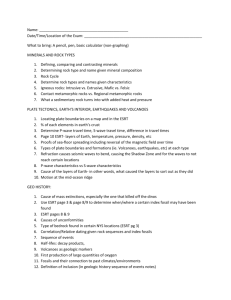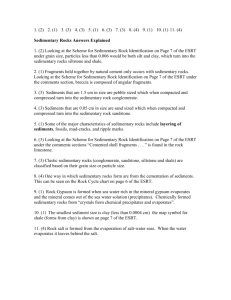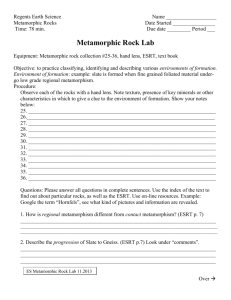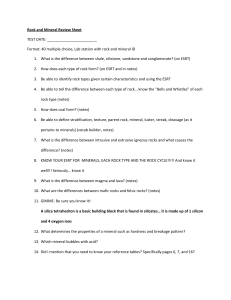Regents Earth Science Name
advertisement
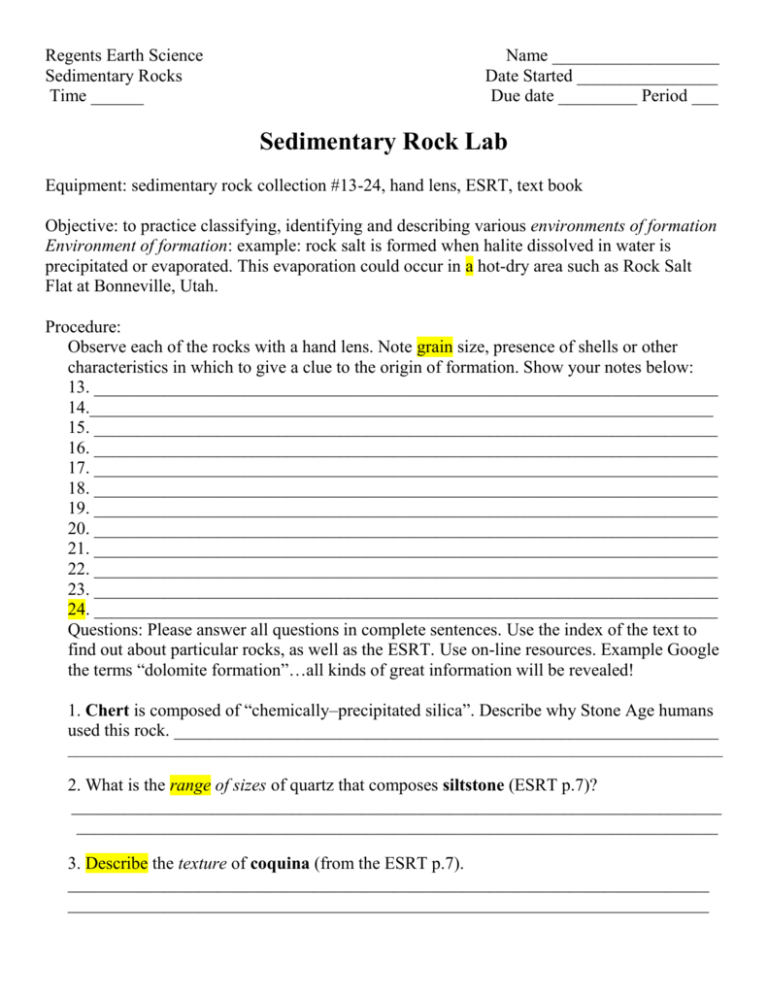
Regents Earth Science Sedimentary Rocks Time ______ Name ___________________ Date Started ________________ Due date _________ Period ___ Sedimentary Rock Lab Equipment: sedimentary rock collection #13-24, hand lens, ESRT, text book Objective: to practice classifying, identifying and describing various environments of formation Environment of formation: example: rock salt is formed when halite dissolved in water is precipitated or evaporated. This evaporation could occur in a hot-dry area such as Rock Salt Flat at Bonneville, Utah. Procedure: Observe each of the rocks with a hand lens. Note grain size, presence of shells or other characteristics in which to give a clue to the origin of formation. Show your notes below: 13. _______________________________________________________________________ 14._______________________________________________________________________ 15. _______________________________________________________________________ 16. _______________________________________________________________________ 17. _______________________________________________________________________ 18. _______________________________________________________________________ 19. _______________________________________________________________________ 20. _______________________________________________________________________ 21. _______________________________________________________________________ 22. _______________________________________________________________________ 23. _______________________________________________________________________ 24. _______________________________________________________________________ Questions: Please answer all questions in complete sentences. Use the index of the text to find out about particular rocks, as well as the ESRT. Use on-line resources. Example Google the terms “dolomite formation”…all kinds of great information will be revealed! 1. Chert is composed of “chemically–precipitated silica”. Describe why Stone Age humans used this rock. ______________________________________________________________ _______________________________________________________________________________________ 2. What is the range of sizes of quartz that composes siltstone (ESRT p.7)? __________________________________________________________________________ _________________________________________________________________________ 3. Describe the texture of coquina (from the ESRT p.7). _________________________________________________________________________ _________________________________________________________________________ 4. Describe the environment for the formation of a conglomerate. _____________________ __________________________________________________________________________ __________________________________________________________________________ __________________________________________________________________________ 5. Sample #17 and #18 are both sandstones. Which sample probably originated closest to the mouth of a river? Explain your reasoning. ________________________________________ __________________________________________________________________________ __________________________________________________________________________ __________________________________________________________________________ __________________________________________________________________________ 6. Describe the environment for the formation of argillaceous shale. _________________________________________________________________________ _________________________________________________________________________ _________________________________________________________________________ __________________________________________________________________________ __________________________________________________________________________ 7. Describe the environment for the formation of bituminous shale. _________________________________________________________________________ _________________________________________________________________________ _________________________________________________________________________ __________________________________________________________________________ __________________________________________________________________________ 8. Dolomitic limestone and dolostone are common rocks in the Pittsford area. Describe the environment of formation for dolostone. ________________________________________ __________________________________________________________________________ __________________________________________________________________________ __________________________________________________________________________ 9. Travertine and gypsum are both chemically formed sedimentary rocks. Which one will bubble with dilute HCL? Explain your reasoning _________________________________ _________________________________________________________________________ __________________________________________________________________________ __________________________________________________________________________


